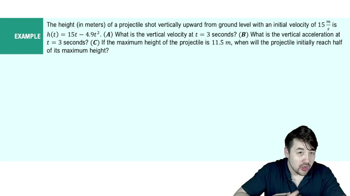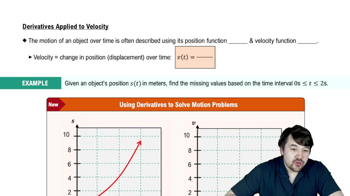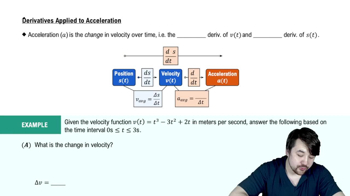The 8-ft wall shown here stands 27 ft from the building. Find the length of the shortest straight beam that will reach to the side of the building from the ground outside the wall.
Table of contents
- 0. Functions7h 54m
- Introduction to Functions16m
- Piecewise Functions10m
- Properties of Functions9m
- Common Functions1h 8m
- Transformations5m
- Combining Functions27m
- Exponent rules32m
- Exponential Functions28m
- Logarithmic Functions24m
- Properties of Logarithms36m
- Exponential & Logarithmic Equations35m
- Introduction to Trigonometric Functions38m
- Graphs of Trigonometric Functions44m
- Trigonometric Identities47m
- Inverse Trigonometric Functions48m
- 1. Limits and Continuity2h 2m
- 2. Intro to Derivatives1h 33m
- 3. Techniques of Differentiation3h 18m
- 4. Applications of Derivatives2h 38m
- 5. Graphical Applications of Derivatives6h 2m
- 6. Derivatives of Inverse, Exponential, & Logarithmic Functions2h 37m
- 7. Antiderivatives & Indefinite Integrals1h 26m
- 8. Definite Integrals4h 44m
- 9. Graphical Applications of Integrals2h 27m
- 10. Physics Applications of Integrals 3h 16m
- 11. Integrals of Inverse, Exponential, & Logarithmic Functions2h 31m
- 12. Techniques of Integration7h 41m
- 13. Intro to Differential Equations2h 55m
- 14. Sequences & Series5h 36m
- 15. Power Series2h 19m
- 16. Parametric Equations & Polar Coordinates7h 58m
5. Graphical Applications of Derivatives
Applied Optimization
Problem 4.5.51a
Textbook Question
51. Frictionless cart A small frictionless cart, attached to the wall by a spring, is pulled 10 cm from its rest position and released at time t = 0 to roll back and forth for 4 sec. Its position at time t is s = 10 cos πt.

a. What is the cart's maximum speed? When is the cart moving that fast? Where is it then? What is the magnitude of the acceleration then?
 Verified step by step guidance
Verified step by step guidance1
To find the cart's maximum speed, we need to determine the derivative of the position function s(t) = 10 cos(πt) with respect to time t. This derivative will give us the velocity function v(t).
The velocity function v(t) is found by differentiating s(t) with respect to t: v(t) = ds/dt = -10π sin(πt).
The maximum speed occurs when the absolute value of the velocity is maximized. Since the sine function oscillates between -1 and 1, the maximum value of |v(t)| is 10π, which occurs when sin(πt) = ±1.
To find when the cart is moving at maximum speed, solve the equation sin(πt) = ±1. This occurs at t = 0.5, 1.5, 2.5, 3.5, etc., within the given time interval of 0 to 4 seconds.
To find the position and acceleration when the cart is moving at maximum speed, substitute t = 0.5 into the position function s(t) and the acceleration function a(t), where a(t) = dv/dt = -10π^2 cos(πt).
 Verified video answer for a similar problem:
Verified video answer for a similar problem:This video solution was recommended by our tutors as helpful for the problem above
Video duration:
6mPlay a video:
Was this helpful?
Key Concepts
Here are the essential concepts you must grasp in order to answer the question correctly.
Simple Harmonic Motion
Simple harmonic motion (SHM) describes the motion of the cart as it oscillates back and forth. The position function s = 10 cos πt indicates that the cart's motion is periodic and sinusoidal, typical of SHM. The amplitude of 10 cm represents the maximum displacement from the rest position, and the angular frequency π determines the speed of oscillation.
Recommended video:

Derivatives Applied To Acceleration Example 2
Velocity in SHM
The velocity of an object in simple harmonic motion is the derivative of its position function with respect to time. For s = 10 cos πt, the velocity v(t) is given by v(t) = -10π sin πt. The maximum speed occurs when the sine function equals ±1, resulting in a maximum velocity magnitude of 10π cm/s.
Recommended video:

Derivatives Applied To Velocity
Acceleration in SHM
Acceleration in simple harmonic motion is the derivative of the velocity function or the second derivative of the position function. For s = 10 cos πt, the acceleration a(t) is a(t) = -10π² cos πt. The magnitude of acceleration is maximum when the cosine function equals ±1, which occurs at the maximum displacement points.
Recommended video:

Derivatives Applied To Acceleration

 1:13m
1:13mWatch next
Master Intro to Applied Optimization: Maximizing Area with a bite sized video explanation from Patrick
Start learningRelated Videos
Related Practice
Textbook Question
